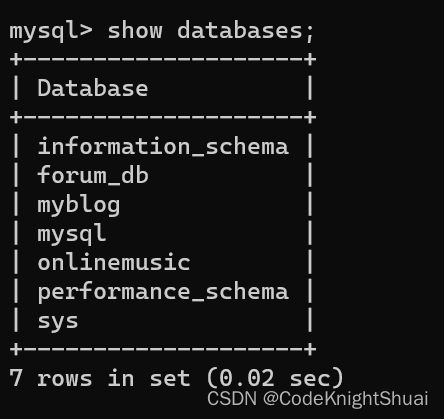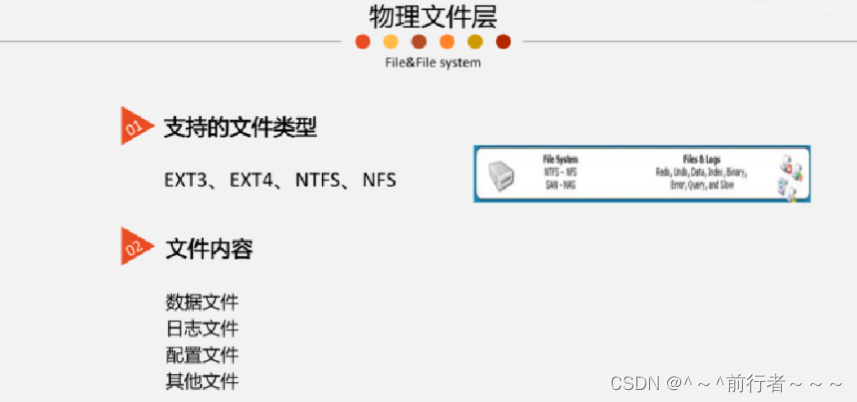

一、定义基本表
1、常用的完整性约束
- 主码约束
primary key
foreign key
unique
- 非空性约束
not null
- 取值约束
check
2、例题
【例1】建立一个“学生”表Student,由学号Sno、姓名Sname、性别Ssex、年龄Sage、所在系Sdept五个属性组成。其中学号不能为空,值是唯一的,并且姓名取值也唯一
create table Student(
Sno char(5) not null unique,
Sname char(20) unique,
Ssex char(1),
Sage number,
Sdept char(15)
);
【例2】建立一个“学生选课”表SC,它由学号Sno、课程号Cno,修课成绩Grade组成,其中(Sno, Cno)为主码
create table SC(
Sno char(5),
Cno char(3),
Grade number,
Primary key(Sno, Cno)
);
二、修改基本表
1、语法格式
ALTER TABLE <表名>
[ ADD <新列名> <数据类型> [ 完整性约束 ] ]
[ DROP <完整性约束名> ]
[ MODIFY <列名> <数据类型> ];
2、例题
【例1】向Student表增加 “入学时间” 列,其数据类型为日期型
alter table Student add Scome date;
alter table Student modify Sage char;
alter table Student drop unique(Sname);
三、删除基本表
1、语法格式
drop table <表名>
2、例题
【例1】删除Student表
drop table Student;
四、建立与删除索引
1、语法格式
-- 建立索引
CREATE [UNIQUE] INDEX <索引名> ON <表名>(<列名>[<次序>][,<列名>[<次序>] ]…);
-- 删除索引
DROP INDEX <索引名>;
2、例题
【例1】为学生 – 课程数据库中的Student,Course,SC三个表建立索引。
create unique index Stusno on Student(Sno);
create unique index Coucno on Course(Cno);
create unique index SCno on SC(Sno ASC, Cno DESC);
drop index Stusname;
五、查询
SELECT [ALL|DISTINCT] <目标列表达式> [<别名>]
[,<目标列表达式>[<别名>]] …
FROM <表名或视图名>[<别名>]
[, <表名或视图名>[<别名>] ] …
[ WHERE <条件表达式> ]
[ GROUP BY <列名> [, <列名>] …
[ HAVING <条件表达式> ] ]
[ ORDER BY <列名> [, <列名>] … [ ASC|DESC ] ];
③ group by 子句:对查询结果按指定列的值分组,该属性列值相等的元组为一个组
⑤ order by 子句:对查询结果表按指定列值的升序或降序排序
学生 - 课程数据库
学生表:
Student(Sno,Sname,Ssex,Sage,Sdept)
课程表:
Course(Cno,Cname,Cpno,Ccredit)
学生选课表:
SC(Sno,Cno,Grade)
1、单表查询
① 选择表中的若干列
《查询指定列》
【例1】查询全体学生的学号与姓名
select Sno, Sname from Student;
【例2】查询全体学生的姓名、学号、所在系
select Sname, Sno, Sdept from Student;
《查询全部列》
【例】查询全体学生的详细记录
select Sno,Sname,Ssex,Sage,Sdept from Student;
select * from Student;
《查询经过计算的值》
select Sname, Sage as 2021-Sage from Student;
② 选择表中的若干元组
在SELECT子句中使用
DISTINCT短语
数据如下:
Sno Cno Grade
----- --- ----
19001 1 92
19001 2 85
19001 3 88
19002 2 90
19002 3 80
- 查询选修了课程的学生学号
-- 未优化前
select Sno from SC;
selct all Sno from SC;
结果: Sno
19001
19001
19001
19002
19002
-------------------------
-- 优化后
select distinct Sno from SC;
结果: Sno
19001
19002
=, >, <, >=, <=, != 或 <>, >, !<
【例1】查询计算机系全体学生的名单
select Sname from Student where Sdep = 'CS';
select Sname, Sage from Student where age < 20;
select Sname, Sage from Student where not age >= 20;
【例3】查询考试成绩有不及格的学生的学号
select distinct Sno from SC where Grade < 60;
- 确定范围
between ... and ...
not between ... and ...
【例1】查询年龄在20~23岁(包括20岁和23岁)之间的学生的姓名、系别和年龄
select Sname, Sdept, Sage from Student where Sage between 20 and 23;
select Sname, Sdept, Sage from Student where not Sage between 20 and 23;
- 确定集合
IN <值表>
NOT IN <值表>
【例】查询信息系(IS)、数学系(MA)和计算机科学系(CS)学生的姓名和性别
select Sname, Ssex from Student where Sdept in ('IS', 'MA', 'CS');
LIKE 或 NOT LIKE
[NOT] LIKE ‘<匹配串>’ [ESCAPE ‘ <换码字符>’]
【例】查询学号为95001的学生的详细情况
select * from Student where Sno like '19001';
select * from Student where Sno = '19001';
【例1】查询所有姓刘学生的姓名、学号和性别
select Sname, Sno, Ssex from Student Sname like '刘%';
【例2】 查询姓 “欧阳” 且全名为三个汉字的学生的姓名
select Sname from Student where Sname like '欧阳_';
【例3】查询名字中第2个字为”阳”字的学生的姓名和学号
select Sname, Sno from Student where like '_阳%';
【例4】查询所有不姓刘的学生姓名
select Sname from Student Sname not like '刘%';
select Cno, Ccredit from Course where Cname like 'DB_Design' escape '';
- 涉及空值的查询
is null 或 is not null
【例】某些学生选修课程后没有参加考试,所以有选课记录,但没有考试成绩。查询缺少成绩的学生的学号和相应的课程号
select Sno, Cno from SC where Grade is null;
【例】查所有有成绩的学生学号和课程号
select Sno, Cno from SC where Grade is not null; -- 有成绩即不为空
- 多重条件查询
【例1】查询计算机系年龄在20岁以下的学生姓名
select Sname from Student where Sdept = 'CS' and Sage < 20;
【例2】查询信息系(IS)、数学系(MA)和计算机科学系(CS)学生的姓名和性别
select Sname, Ssex from Student where Sdept in ('IS', 'MA',' CS');
【例3】查询年龄在20~23岁(包括20岁和23岁)之间的学生的姓名、系别和年龄
select Sname, Sdept, Sage from Student where Sage between 20 and 23;
③ 对查询结果排序
- 升序:ASC
- 降序:DESC
【例1】查询选修了3号课程的学生的学号及其成绩,查询结果按分数降序排列
select Sno, Grade from SC where Cno = '3' order by Grade desc;
结果:
Sno Grade
------- -------
19010
19024
19007 92
19003 82
19010 82
19009 75
19014 61
19002 55
【例2】查询全体学生情况,查询结果按所在系的系号升序排列,同一系中的学生按年龄降序排列
select * from Student where Sdept, Sage desc;
④ 使用集合函数
COUNT([DISTINCT|ALL] *)
COUNT([DISTINCT|ALL] <列名>)
SUM([DISTINCT|ALL] <列名>)
- 计算平均值
AVG([DISTINCT|ALL] <列名>)
- 求最大值
MAX([DISTINCT|ALL] <列名>)
- 求最小值
MIN([DISTINCT|ALL] <列名>)
【例1】查询学生总人数
select count(*) from Student;
【例2】查询选修了课程的学生人数
select count(distinct Sno) from SC;
-- 注:用DISTINCT以避免重复计算学生人数
【例3】计算1号课程的学生 平均 成绩
select AVG(Grade) from SC where Cno = '1';
【例4】查询选修1号课程的学生 最高 分数
select max(Grade) from SC where Cno = '1';
⑤ 对查询结果分组
select Cno, count(Cno) from Sc Group by Cno;
--------------------------------------------
结果:
Cno COUNT(Sno)
1 22
2 34
3 44
4 33
5 48
【例2】求各个课程号及相应的课程成绩在90分以上的学生人数
select Cno, Count(Sno) from Sc where Grade > 90 Group by Cno;
----------------------------------------
结果
Cno COUNT(Sno)
1 13
2 7
4 3
5 8
【例1】查询选修了3门以上课程的学生学号
select Sno from SC Group by Sno Having Count(*) > 3;
【例2】 查询有3门以上课程在90分以上的学生的学号及90分以上的课程数
select Sno, Count(*) from SC where Grade > 90 Group by Sno Having Count(*) > 3;
HAVING短语与WHERE子句的区别?
2、连接查询
同时涉及多个表的查询称为连接查询
一、广义笛卡尔积
select Student.*, Sc.* from Student, SC;
-- .*代表这个表中所有的字段
二、等值与非等值连接查询
[<表名1>.]<列名1> = [<表名2>.]<列名2>
-- 任何子句中引用表1和表2中同名属性时,都必须加表名前缀。引用唯一属性名时可以加也可以省略表名前缀
select Student.*, Sc.* from Student, SC where Student.Sno == SC.Sno;
三、自身连接查询
一个表与其自己进行连接,称为表的自身连接
【例】查询每一门课的间接先修课(即先修课的先修课)
select a.Cno, b.Cno from Course a, Course b where a.Cpon = b.Cno;
四、外连接查询
外连接与普通连接的区别
【例】以学生为主体,查询每个学生及其选修课程的情况 (用外连接)
SELECT Student.Sno, Sname, Ssex, Sage, Sdept, Cno, Grade FROM Student,SC
WHERE Student.Sno = SC.Sno(+);
五、复合条件连接查询
WHERE子句中含多个连接条件时,称为复合条件连接
假设学校中性别相同的学生不会重名。现如下设计学生表和选课表:
Std(Sname, Ssex, Sage, Sdept)
StdC(Sname, Ssex, Cno, Grade)
【例1】查询选修2号课程且成绩在90分以上的所有学生的姓名,性别及所在系
select Sname, Ssex, Sdept from Std, StdC
where Std.Sname = StdC.Sname and Std.Ssex = StdC.Ssex
and StdC.Cno = '2'
and StdC.Grade > 90;
【例2】查询每个学生的学号、姓名、选修的课程名及成绩( Student,SC,Course )
select Student.Sno, Student.Sname, Course.Cname, SC.Grade
from Student, SC, Course
where Student.Sno = SC.Sno
and SC.Cno = Course.Cno;
3、嵌套查询
① 嵌套查询概述
【嵌套查询】:将一个查询块嵌套在另一个查询块的 WHERE子句 或 HAVING短语 的条件中的查询
-- 查询所有选修了2号课程的学生姓名
-- 外层查询/父查询
select Sname from Student where Sno in (
-- 内层查询/子查询
select Sno from SC where Cno = '02'
);
select Sname from Student, SC where Student.Sno = SC.Sno and Cno = '02';
② 嵌套查询分类
- 不相关子查询
- 子查询的查询条件不依赖于父查询
- 相关子查询
- 子查询的查询条件依赖于父查询
③ 嵌套查询求解方法
一、不相关子查询
【例】查询与“刘晨”在同一个系学习的学生
-- 确定 “刘晨” 所在系名
select Sdept from Student where Sname = '刘晨';
-- 查找所有在IS系学习的学生
select Sno, Sname, sdept from Student where Sdept = 'IS';
-- 合并查询
select Sno, Sname, Sdept from Student where Sdept in (
select Sdept from Student where Sname = '刘晨';
)
二、 相关子查询
【例】查询所有选修了1号课程的学生学号、姓名。用嵌套查询
select Sno, Sname from Student where exists (
select * from SC where Sno = Student.Sno and Cno = '1'
);
-- 注: EXISTS 关键字在 SQL 中用于检查子查询是否至少会返回一行数据,它通常与相关子查询一起使用。
④ 引出子查询的谓词
- 带有IN谓词的子查询
-- 最后在Student表中根据这个学生的学号取到相关学生的姓名
select Sno, Sname from Student where Sno in (
-- 然后根据所找到的课程号在SC中算选出选修了3号课程的学生学号
select Sno from SC where Cno in (
-- 首先在Course表中找出课程名为 "信息系统" 的课程号
select Cno from Course where Cname = '信息系统'
)
);
- 连接查询
select Sno, Sname from Student, SC, Course
where Student.Sno = SC.Sno and SC.cno = Course.cno
and Course.Cname = '信息系统'
【例】查询与 “刘晨” 在同一个系学习的学生
select Sno, Sname, Sdept from Student where Sdept = (
select Sdept from Student where Sname = '刘晨'
);
- 带有ANY或ALL谓词的子查询
-
ANY:任意一个值
-
ALL:所有值
需要配合使用比较运算符:
> ANY 大于子查询结果中的某个值
> ALL 大于子查询结果中的所有值
< ANY 小于子查询结果中的某个值
< ALL 小于子查询结果中的所有值
>= ANY 大于等于子查询结果中的某个值
>= ALL 大于等于子查询结果中的所有值
<= ANY 小于等于子查询结果中的某个值
<= ALL 小于等于子查询结果中的所有值
= ANY 等于子查询结果中的某个值
=ALL 等于子查询结果中的所有值(通常没有实际意义)
!=(或<>)ANY 不等于子查询结果中的某个值
!=(或<>)ALL 不等于子查询结果中的任何一个值
【例】查询其他系中比信息系某一学生年龄小的学生姓名和年龄
select Sname, Sage from Student where Sage < any(
select Sage from Student where Sdept = 'IS'
) and Sdept <> 'IS';
- 带有EXISTS谓词的子查询
exists作为 where 条件时,是先对where 前的主查询进行查询,然后用主查询的结果一个一个的代入exists的子查询进行判断,如果为真则输出当前这一条主查询的结果,否则不输出
例1:查询所有选修了1号课程的学生姓名
-- 嵌套查询
select sname from Student where exists (
select * from SC where sno = Student.sno and cno = '1';
);
-- 连接查询
select sname from Student, SC where Student.sno = SC.sno and cno = '1';
例2:查询没有选修了1号课程的学生姓名
select sname from Student where not exists (
select * from SC where sno = Student.sno and cno = '1';
);
例3:查询与“刘晨”在同一个系学习的学生
-- 不相关子查询
select Sno, Sname, Sdept from Student where Sdept in (
select Sdept from Student where Sname = '刘晨';
)
-- 带EXISTS谓词的子查询替换
select Sno, Sname, Sdept from Student S1 where exists (
select * from Student S2 where S2.Sdept = S1.Sdept and S2.Sname = '刘晨'
);
效率对比
例4:查询选修了课程的学生姓名
-- Way1:
select Sname from Student where exists (
select * from SC where Sno = Student.Sno
);
-- Way2:
select Sname from Student, SC where Student.Sno = SC.Sno;
-- Way3:
select Sname from Student where sno in (
select distinct sno from sc
);
例5:查询选修了全部课程的学生姓名
-- 查询没有出现不选所有课的学生
select Sname from Student where not exists (
select * from Course where not exists (
select * from SC where Sno = Student.Sno and Cno = Course.cno
)
);
例6:查询至少选修了学生19002选修的全部课程的学生号码
-- 不存在这样的课程y, 学生19002选了,但是学生x却没有选
select distinct Sno from SC SCX where not exists (
select * from SC SCY where SCY.Sno = '19002' and not exists (
select * from SC SCZ where SCZ.Sno = SCX.Sno and SCZ.Cno = SCY.Cno
)
);
4、集合查询
① 并操作(union)
<查询块>
UNION
<查询块>
-- 参加UNION操作的各结果表的列数必须相同; 对应项的数据类型也必须相同
例1:查询计算机科学系的学生及年龄不大于19岁的学生
-- way1: 并
select * from Student where Sdept = 'CS' union
select * from Student where Sage <= 19;
-- way2: 或
select distinct from Student where Sdept = 'CS' or Sage < 19;
例2:查询学校中所有师生的姓名
select Sname from Student union
select Sname from Teacher;
② 交操作(intersect)
例1:查询选修课程1的学生集合与选修课程2的学生集合的交集
-- 使用insersect
select Sno from SC where Cno = '1' intersect
select Sno from SC where Cno = '2';
-- 用 in 谓词
select Sno from SC where Cno = '1' and Sno in (
select Sno from SC where Cno = '2'
)
例2:查询学生姓名与教师姓名的交集
-- 使用insersect
select distinct Sname from Student intersect
select distinct Sname from Teacher;
-- 用 in 谓词
select distinct from Student where Sname in (
select Sname from Teacher;
)
例1:查询学生姓名与教师姓名的差 ——> 查询学校中未与教师同名的学生姓名
-- 使用except
select distinct Sname from Student except
select distinct Sname from Teacher;
-- 用 in 谓词
select distinct from Student where Sname not in (
select Sname from Teacher;
)
④ 对集合操作结果的排序
任何情况下,ORDER BY子句只能出现在最后
5、小结
SELECT [ALL|DISTINCT] <目标列表达式>
[别名] [ ,<目标列表达式> [别名]] …
FROM <表名或视图名> [别名]
[ ,<表名或视图名> [别名]] …
[WHERE <条件表达式>]
[GROUP BY <列名1>[,<列名1’>] ...
[HAVING <条件表达式>]]
[ORDER BY <列名2> [ASC|DESC]
[,<列名2’> [ASC|DESC] ] … ];

原文地址:https://blog.csdn.net/Fire_Cloud_1/article/details/134373417
本文来自互联网用户投稿,该文观点仅代表作者本人,不代表本站立场。本站仅提供信息存储空间服务,不拥有所有权,不承担相关法律责任。
如若转载,请注明出处:http://www.7code.cn/show_9195.html
如若内容造成侵权/违法违规/事实不符,请联系代码007邮箱:suwngjj01@126.com进行投诉反馈,一经查实,立即删除!





